Rottefella Xplore Backcountry Off-Track

A smart, simple, and lightweight binding that tours well and can deliver sweet turns in reasonably friendly terrain and snow conditions. Step-in, pole-out convenience. Interchangeable flex plates for touring, climbing, and downhill add versatility but can be a bit fiddly.
Pros
- Lightweight
- Mechanically simple
- Interchangeable flex plates for touring, climbing, and downhill modes
- Step-in, step out with a pole stab
- 70 mm wide engagement with the boot toe
Cons
- Step-in requires verification to make sure both pins engaged
- Changing flex plates can be a bit fiddly, easy to lose
- Heel lifts a bit tricky to flip with a pole grip
- Spring pins in compatible boots potentially vulnerable to damage

Ever since I first ripped out the pin holes on a 75mm Nordic Norm boot in the first season of my telemark career (over 40 years ago!), I’ve been willing to try out just about any other backcountry boot-binding system that has come along. Within a year after doing my first telemark turns, I tried the short-lived 50 mm Trakker system, maybe the first binding to introduce ridges and grooves on the binding and boot, respectively, an innovation that was picked up by both Rottefella and Salomon in their revolutionary xc systems (NNN and SNS respectively).
When Karhu produced a stiff-ish boot for the first-generation SNS system, I jumped right in. Without going into details, neither of those early iterations was satisfactory, so it was back to 75 mm 3-pin and cable systems until Rottefella introduced NNN-BC ca. 1989. Although I still used 75 mm on bigger skis, NNN-BC became my system of choice for a broad range of backcountry tours, especially of the hut-to-hut variety where the kick-and-glide touring efficiency of a toe bar-type binding pays off. NNN-BC doesn’t give enough stability and control when conditions get variable or difficult, but in soft and consistent snow it can deliver a lot of fun and efficiency.
For some of the steeper terrain and more difficult snow conditions I met up with here in Norway, I finally upgraded to plastic 75 mm boots (Scarpa T2s) but the weight advantage and touring efficiency of a free heel system is pretty much erased with heavy tele gear, so I ultimately switched to rando for (relatively) big mountain day trips. “Old tele skiers never die, they just go rando!”
Much as I might have liked to try it, I never invested in NTN or any of the tele-tech variants, because the boots and bindings cost a boatload, are heavy, and don’t offer the touring versatility of a true BC system. There will always be a place in my heart, and my quiver, for a ski-boot-binding system that can offer up touring efficiency in rolling terrain and downhill fun in at least reasonably friendly snow conditions.
All this goes to say, when I heard Rottefella was offering up a whole new system, well, I knew I would have to give it a try. It might have been smart to wait a year for beta testing, but when a Norwegian retailer offered up a deeply discounted package price in the middle of the 2022 season, I pulled the trigger. I have put the full rig to work mainly out my back door in Bymarka, one of Trondheim’s ski playgrounds, with a couple hundred kilometers of groomed xc ski trails that can be used to access various powder stashes if you know where to look. Accordingly, this is one of a triad of reviews on the components of the full package. The other components are the Åsnes Rabb 68 ski and the Alfa Free boot.
So what?
When Rottefella announced the new system it was met with the usual mix of breathless anticipation on the part of some and deep skepticism from others (especially the 75mm forever crowd—many passed judgement on it without actually, um, trying it). The prevailing question: Is this really any better than any of the choices we already have? After putting the binding to work in a variety of conditions over the last year I can say, with some caveats, I think it is.
Rather than reinvent the wheel, I’ll let Rottefella demonstrate the features and operation of the binding in his short video.
The Xplore binding clearly takes a cue from Dynafit-type rando bindings in that it uses a pin and socket system to attach boot to ski, but flips it around – the pins are on the boot, the sockets in the binding. The pins are spring loaded, retract while stepping into the binding and then snap into the sockets. For easy exit, a push with a ski pole on the bail at the front of the binding pushes the pins in and the boot twists free. This delivers step-in step-out convenience mostly as advertised, with the caveat that, when stepping in, sometimes only one pin will engage at first, so it can take some wiggling and a quick check to make sure both pins are snapped into place.

Jamming with Xplore
Some users, including yours truly, had one of the pins jam in the retracted position in the boot, rendering the system useless. I’ll go into that in more detail in my review of the boot, but here note that the Rottefella attributed the problem to a manufacturing defect specific to the Alfa Free boot, replaced all four pins for free, covered all shipping expenses, and sent me a few goodies as an apology for the inconvenience:

In my case the problem hasn’t recurred since the repair, and the indignation on the internet, mainly in Norway, seems to have died down, so maybe the crisis has been resolved. Internet wisdom offers up a fix for the problem that involves pushing the opposite pin all the way in to force the problem pin out on the other side, requiring some sort of suitable tool; I haven’t had the opportunity to try it out.
It also seems to me that the pins may be vulnerable to damage when i.e. scrambling to a rocky summit, but I have done a little bit of that activity and so far so good.
Why weight?
Putting all that aside, the Xplore offers some real advantages over NNN-BC. I never liked the step-in version of NNN-BC, preferring the Magnum variant which weighs in at 529 g per pair, versus 378 for the Xplore. The manual NNN-BC requires bending over to get in and out, as do 75 mm 3-pin and many cable options, while Xplore's step-in pole out functions are faster and very convenient.
More importantly, snow and ice can build up in the cavity around the bar in NNN-BC boots, so they often require cleaning before inserting into the binding. The space between the ridges on NNN-BC bindings can also trap snow, sometimes resulting in upward leverage that can stress and break the toe bar (been there, done that, many times). With the Xplore binding, I have had a cm or so of snow build up on the plastic plates under the ball of the foot and on the heel plate, especially in sticky conditions, but not enough to affect my skiing or unduly stress the boot or binding.
Rottefella and some users like to point out that Xplore boots engage the full width of the binding, 70 mm rather than just the 30 mm of the bar in an NNN-BC boot. Whatever—I think that the real limitation is the torsional rigidity of the boot, which I’d say is slightly better in my Xplore than my NNN-BC boots, both at the high/stiff end of the spectrum.
What’s on your plate?
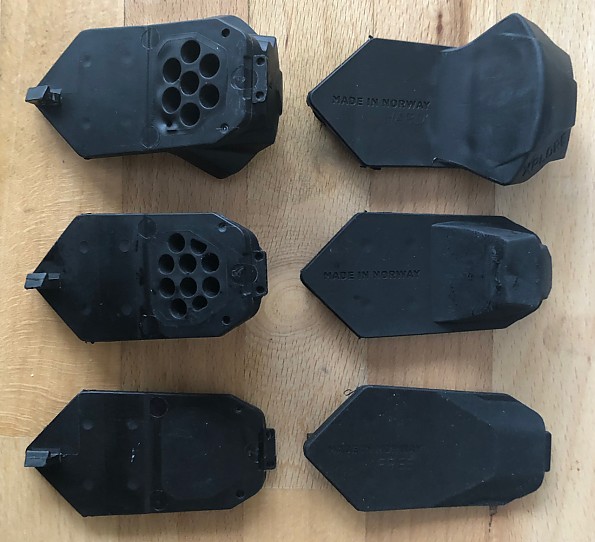
The Xplore binding’s interchangeable flex plates offer a way to tune the binding’s performance to preference and conditions. The standard soft flex plate works well for kick-and-glide touring and descending on easy ground, giving some of the same feel as an NNN classic binding, albeit with a much stiffer boot. The free pivot plate is for long, rando-style hill climbs—my choice for long ascents to easier summits in good conditions. The hard flex plates offer more resistance to heel lift, giving more control over the tip of the ski when doing telemark turns.

Switching plates looks easy in the video, but it takes some finger strength applied at just the right point on the release button on the side of the binding. I found it a bit tricky at first, but now do it routinely, not just indoors as in the video, but with gloves or even mittens on at the top of a powder run.
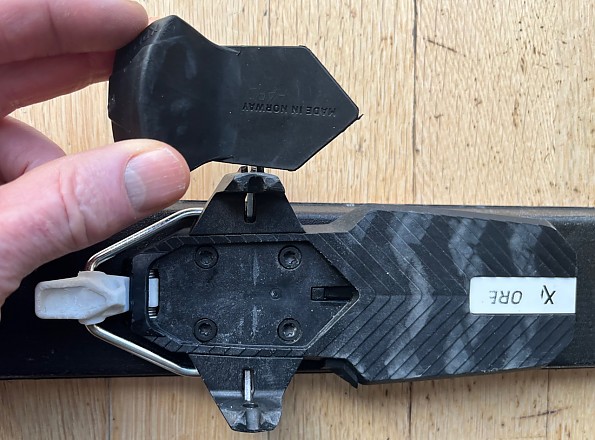
I recently did four laps at a local little alpine ski hill, with lifts closed and in mashed potato snow, switching between the standard and hard plates at the top and bottom of each run, all without taking my xc weight gloves off. I could have climbed using the hard plates or descended on the soft ones, but that would have meant a lot more work or less control/fun, respectively. It’s obviously necessary to step out of the binding and pick up the ski to switch plates, unlike with full-on skimo gear where you can rip skins and switch to downhill mode with skis on. But I’m not trying to win any races, just have a good time, so the minute or two extra to switch plates is worth it.
As with stepping into the binding, it’s a good idea to make sure the plates are fully engaged with an audible click. The boot will actually help keep them in place, but if you take the ski off and pick it up without pay attention, the plate can pop loose, maybe never to be found again (happened once).
With repeated flexing, a little snow can work in under the plate and sometimes into the mechanism. In sticky conditions I have sometimes had to blow into the hole at the back end to clear ice and be sure the plate will engage. There is also the possibility of fumbling and losing one in the snow when changing plates, so some care is required there as well.
Spare plates cost me about 99 kroner (call it $10) a pair. Like the flexors in NNN and NNN-BC bindings, the standard flexor can fatigue and crack over the course of a season or two. It will keep working, but with less resistance and so needs replacement from time to time. The hard flex plates have held up well over two seasons' worth of use.
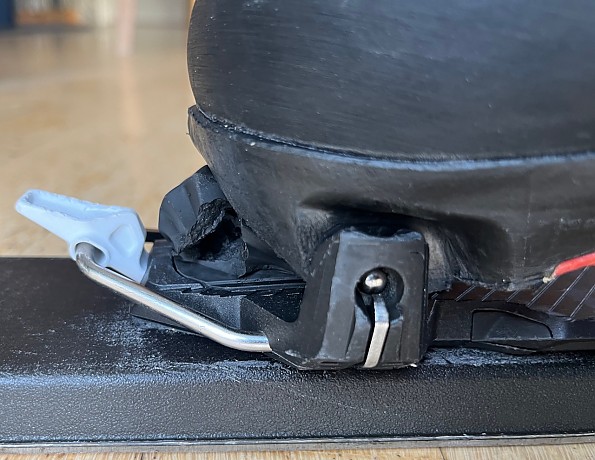
A cracked flexor
A boy can dream of some variation of the Xplore binding that switches between uphill/touring/downhill modes with the flick of a pole tip, but I suppose it would be more complex/heavier and so far the interchangeable flex plates have worked well enough.
Put on your high-heeled sneakers
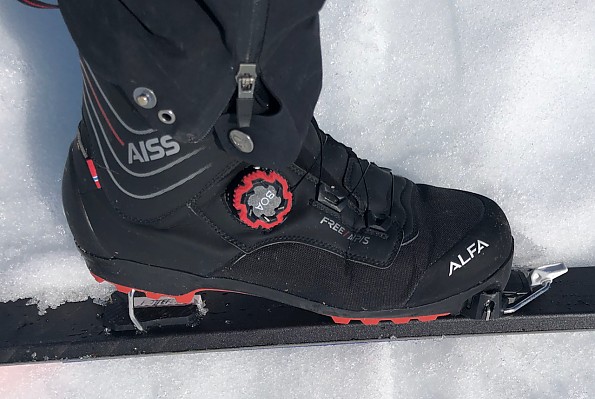
The heel lifts raise the boot heel by 36 mm (about 1.5 inches) for more comfortable climbing on steeper slopes. I haven’t used them all that much, and consequently haven’t really made friends with them. I’m mainly using short skins that cover only the middle third of the ski and with those I can’t climb very steeply. So far, I find the heel lifts rather stiff and difficult to deploy with a ski pole. As with heel lifts on some rando bindings it usually works better to invert the pole and use the slight lip on the pole handle rather than try to do it with the pole basket (impossible in this case), but I find it a bit difficult to get the right angle to hook the bar. That they fold down forward doesn’t help much because I have to get my pole that much further under my boot heel. Maybe it will get easier with practice, but for now the heel lifts seem less than ideal.
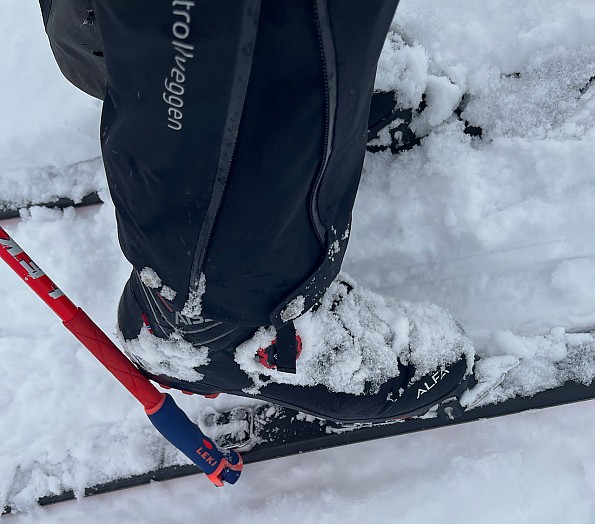
It's all downhill from here
Any BC binding is necessarily a compromise between weight, touring versatility, and downhill performance (and cost). I might hope, but can’t really expect, to be able to wiggle down a steep slope or hold an edge on hard snow just like I do on my rando gear, but neither skis nor bindings are fully up to that task. Back in the day I might have tele-jump-turned my way down Tuckerman Ravine on a pair of toothpicks with leather boots broken into the consistency of overbaked potatoes, but that takes a lot of energy and I’d rather ski smooth anyway.
I’ve had many a fine powder day on a pair of beat-up Karhu XCD GTs with NNN-BC bindings, and that’s the feeling I’m looking for—the float, the swoosh, the bounce, the controlled smear on spring corn. In friendly snow and with the right skis and boots, these bindings can deliver all that, at maybe half the weight and cost of a full-on rando or heavy tele rig, with smooth kick-and-glide touring on the approach. There could be a lot of light and fast fun in using the Xplore system on a fat ski in pure powder, but for all-round use I wouldn't recommend going much bigger than the Rabb 68 (68 mm at the waist).

Background
I have been a skier of one kind or another for over 60 years, including 20+ as a telemark and backcountry skier with many hundreds of ascents and descents in Vermont glades and Norwegian mountains, including on long hut-to-hut tours. I have been using the Xplore as my main BC bindings for about two years, mainly in local backcountry but also on hut-o-hut trips with summits on the side.
Source: bought it new
Price Paid: About NOK 1500 ($150)
Your Review
Where to Buy
You May Like
Specs
| Price |
Current Retail: $199.95-$249.95 Historic Range: $198.71-$249.95 |

